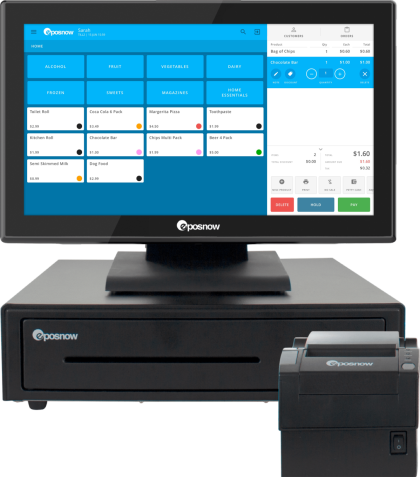How to Start a Grocery Store: A guide for Success in 2023
Are you thinking about starting a grocery store business in 2023? Well, you've come to the right aisle! Starting a grocery store can be a rewarding and profitable venture, but it also requires a lot of planning, hard work, and dedication.
If you're up for the challenge and ready to learn how to start a grocery store, then let's dive in! This guide will cover everything you need to know to get your grocery store business off the vine, from market research and planning to managing finances and operations. We'll also provide tips and resources to help you along the way.
So, whether you're a seasoned business owner or a first-time entrepreneur, this guide will give you the tools you need to start and run a successful grocery store business in 2023. Let's get started!
What is a grocery store?
A grocery store, also known as a supermarket, is a retail establishment that sells various food and household products. These stores typically carry fresh produce, meats, dairy products, baked goods, and canned and packaged goods. Some grocery stores also sell non-food items such as cleaning supplies and personal care products. In addition, some grocery stores may sell alcohol as part of their business model.
The grocery store industry is a vital part of the economy and plays a major role in the grocery industry. Supermarkets are a common sight in most neighborhoods and are a convenient one-stop shop for customers to purchase the food and household items they need. They vary in size, from small convenience stores to large warehouse-style supermarkets.
Grocery stores come in different forms, and each business model has its unique characteristics. Some are small grocery stores that are locally owned, while others are part of larger chains. Some grocery stores focus on providing organic and natural products, while others focus on providing a wide variety of products at low prices.
It's important for anyone thinking about starting a grocery store business to understand the grocery store industry, the various business models, and the trends and developments affecting the grocery industry. This will help develop your business strategy and ensure that you make informed decisions when setting up and running your own grocery store.
Step 1: Market research and planning
This section will discuss the importance of market research and planning for your grocery store business. We'll cover key topics such as identifying your target market, conducting a competitive analysis, developing a business plan, and securing financing. These are all essential steps in getting your grocery store business set up for success.
Identifying the target market
Identifying your target market is key to the success of grocery stores. It's important to understand the demographics, needs, and preferences of your potential customers in order to tailor your products, services, and marketing strategies to meet their demands. Consider factors such as age, income, location, and shopping habits when identifying your target market.
Conducting a competitive analysis
Conducting a competitive analysis is a crucial step in the market research and planning process. It involves researching and analyzing your competitors (other grocery stores) to identify their strengths, weaknesses, and areas of opportunity. This information can be used to differentiate your grocery store business and develop strategies to attract and retain customers.
Developing a business plan
A grocery store business plan is a detailed document that outlines your business objectives, strategies, and tactics. It serves as a roadmap for starting and growing your grocery store business. A well-written business plan should include:
- An executive summary.
- A market analysis.
- A management plan.
- A grocery sales and marketing plan.
- A financial plan.
Start-up costs involved
Starting a grocery store business involves significant start-up costs. These costs can include leasing a commercial space, purchasing equipment, inventory, and other necessary supplies, obtaining a retail food store license, federal taxes, and general liability insurance.
To minimize start-up costs, grocery store owners should conduct thorough market research and plan for the business carefully. Moreover, being mindful of the budget, negotiating with suppliers, and seeking out financing options such as loans or investors can help to manage start-up costs.
Securing financing
Securing financing is a crucial step in starting grocery stores. It involves obtaining the funds necessary to cover the costs of starting and operating the business. Several options for financing a grocery store business include loans from banks and other financial institutions, crowdfunding, and investors.
At Epos Now, we offer a new financing solution called Epos Now Capital that provides SMEs with up to £1M in funding to drive business growth, marketing investment, and cash flow management. There’s no hidden fees, no fixed monthly payments - just instant access to business cash advances, repaid only when your customers pay you.
TIP: Check out our grocery store profit margins blog to find out how much grocery store owners make!
Step 2: Store design and layout
This section will discuss the importance of store design and layout for your grocery store business. We'll cover key topics such as choosing a location, designing the interior and exterior of the store, and selecting and organizing products. These are all essential steps in creating a visually appealing and functional grocery store that will attract and retain customers.
Choosing a business location
Choosing the right location for your grocery store is crucial for its success. Consider factors such as population density, traffic flow, parking, and competition when selecting a location. Look for a location that is easily accessible and visible to potential customers. Remember that a retail food store license may be required in your area.
Designing the interior and exterior of the store
Designing the interior and exterior of your grocery store is an important step in creating a visually appealing and inviting space for customers. Consider factors such as lighting, color schemes, signage, and layout when designing the interior and exterior of the store. The design should be consistent with the brand and image of your grocery store.
Selecting and organizing products
Selecting and organizing products is important in creating a functional and visually appealing grocery store. Consider factors such as product demand, price points, and product placement when selecting and organizing products. Keep in mind that customers should be able to easily find what they are looking for in your grocery store.
By following these guidelines, you can design a great grocery store that will attract and retain customers.

Boost Sales With a Versatile Grocery Store POS System
Manage a diverse inventory and serve customers faster with a powerful and easy-to-use grocery store point of sale solution.
Step 3: Staffing and training
In the context of starting and running grocery stores, staffing and training are essential elements that determine the success of the business. Effective staffing and training can ensure that the business runs smoothly and the customers are satisfied. In this section, we will discuss the importance of hiring and training employees, creating a positive work environment and the strategies that can be employed to achieve these goals.
Hiring and training employees
Hiring the right employees is critical for grocery stores. The employees represent the business and interact with the customers on a daily basis. In this regard, it is important to hire individuals who possess the necessary skills and are a good fit for the grocery business. Once hired, providing the employees with adequate training is crucial. Training programs should be designed to equip employees with the knowledge and skills they need to perform their duties effectively. Resources such as the Small Business Administration (SBA) offer guidance and training materials for small business owners to develop and implement effective employee training programs.
Creating a positive work environment
Creating a positive work environment is essential for the success of a grocery store. A positive work environment can help to improve employee morale, reduce turnover rates and improve customer service. Grocery store owners can achieve this by providing employees with a fair wage and benefits, promoting a healthy work-life balance, and fostering open communication and collaboration.
Step 4: Marketing and advertising
Marketing and advertising are key elements in the success of grocery stores. In this section, we will discuss the importance of developing a marketing plan, utilizing social media and online advertising, and building a customer loyalty program. These strategies can help to attract and retain customers, build brand awareness, and increase sales for your own grocery store.
Developing a marketing plan
Developing a marketing plan for grocery stores is an essential step. A marketing plan should include a clear description of the target market, a competitive analysis, a SWOT analysis, and a description of the marketing strategies and tactics that will be used to reach the target market. It's important to stay up to date with market trends, such as the growing demand for natural and organic foods and other healthy options, when developing your marketing plan.
Utilizing social media and online advertising
Utilizing social media and online advertising for grocery stores is an effective way to reach and engage with potential customers for your grocery business. Social media platforms like Facebook, Instagram, and Twitter can be used to promote new products, sales, and events. Online advertising, such as Google Ads and Facebook Ads, can be used to target specific demographics and increase brand awareness.
Building a customer loyalty program
Building a customer loyalty program is an effective way to attract and retain customers for your own grocery store. A customer loyalty program can include rewards such as discounts, coupons, and special promotions for frequent customers. By offering incentives for repeat business, you can encourage customers to return to your own grocery store, increasing sales and building a loyal customer base.
TIP: Epos Now seamlessly integrates to a number of marketing and loyalty programs that you can use to attract new customers and build a loyal following. Check them out!
By following these strategies and keeping in mind market trends, you can enhance your grocery store business idea and increase your chances of success.
Step 5: Operations and logistics
Operations and logistics are critical components of running a successful grocery store. This section will discuss the importance of establishing inventory management systems, establishing supplier relationships, and handling customer service and complaints. By implementing efficient operations and logistics strategies, grocery stores can ensure the smooth and timely delivery of products and services to customers.
Setting up inventory management systems
Setting up inventory management systems is essential for grocery stores to ensure they have the right products in stock at the right time. An efficient inventory management system can help grocery stores to track and monitor inventory levels, reorder products, and prevent stockouts. It is important to consider options such as a point of sale (POS) system, which not only help with inventory management but also with payment processing services.
Establishing supplier relationships
Establishing strong supplier relationships is crucial for grocery stores to ensure a steady and reliable supply of products. By building relationships with suppliers, grocery stores can negotiate better prices and terms and receive priority service and support. It's important for grocery stores to carefully research and select suppliers and to establish clear communication and expectations with them.
Handling customer service and complaints
Handling customer service and complaints is an important aspect of running a grocery store. It is essential to provide customers with timely and efficient service and address and resolve complaints professionally and courteously. By providing excellent customer service, grocery stores can build a loyal customer base and improve their reputation in the community.
Step 6: Managing finances
Managing finances is crucial to running a successful business, including grocery stores. In this section, we will discuss the importance of setting and managing a budget, keeping accurate financial records, and planning for growth and expansion. By implementing sound financial management strategies, grocery stores can ensure long-term financial stability and growth.
Setting and managing a budget
Setting and managing a budget is essential for any business, including grocery stores. A budget provides a clear financial plan for the business and helps to ensure that expenses do not exceed revenues. It is important to regularly review and update the budget to reflect changes in the business, such as increased sales or unexpected expenses.
Keeping accurate financial records
Keeping accurate financial records is critical for any business, including grocery stores. Financial records provide a clear picture of the business's financial health and are essential for tax purposes. Maintaining records of all financial transactions, including income, expenses, and payments is important.
Planning for growth and expansion
Planning for growth and expansion is an important aspect of managing finances for a business, including grocery stores. By setting financial goals and regularly reviewing and updating financial plans, businesses can ensure they have the resources and funding necessary to grow and expand. This may include opening new locations, expanding product lines, or investing in new technology. Setting up a business bank account, building business credit, and obtaining a business credit card can also help to support growth and expansion.
How can a retail POS system help your grocery store?
A retail POS system, also known as a point of sale system, is a powerful tool that can help streamline and improve your grocery store's operations. A POS system typically includes hardware and software that can be used to process transactions, track inventory, and generate reports. Implementing a retail POS system in your grocery store can bring many benefits, including:
- Improved inventory management: A retail POS system can help to streamline inventory management by automatically tracking inventory levels and reordering products when necessary. This can help to prevent stockouts and ensure that your small grocery store always has the products that customers want.
- Increased efficiency: Want help with increasing your grocery store's efficiency by automating tasks, such as processing transactions and generating reports? A retail POS system is the answer! This can free up your employees' time to focus on other important tasks, such as customer service and inventory management.
- Enhanced customer service: A retail POS program can help to improve customer service by allowing your employees to process transactions quickly and efficiently. It can also provide your employees with important customer data, such as purchase history, that can be used to provide personalized service and recommendations.
- Better data analysis: A grocery store POS system can provide your grocery store with valuable sales, inventory, and customer behavior data. This data can be used to make informed business decisions, such as which products to stock or which promotions to run.
Overall, implementing a retail POS system in your small grocery store can help improve your business's efficiency, customer service, and profitability. So, it's worth considering investing in a retail POS system for your grocery store.
TIP: Check out our comparison blog to discover the best pos system for grocery store today!
Final thoughts
Starting a grocery store can be a challenging and rewarding experience, but it requires careful planning and execution. As a grocery store owner, it's important to conduct market research and develop a business plan, choose the right location, design and layout of the store, and select and organize products. Additionally, effective staffing and training, efficient operations and logistics, and sound financial management are key to the business's success.
Marketing and advertising and implementing a retail POS system can also play an important role in attracting and retaining customers, building brand awareness, and increasing sales. Additionally, understanding the basics of the grocery store industry, the various business models, and the trends and developments affecting the industry can help inform your own business strategy and ensure informed decisions.
It's also worth considering the legal structure of your business, such as a limited liability company (LLC), which can provide personal protection and tax benefits while still allowing you to run the business as you see fit. By following these guidelines and seeking out resources such as the Small Business Administration, you can set your grocery store up for success in the future.




